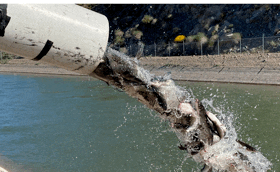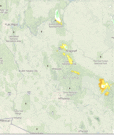Daniel Salzler No. 1042
EnviroInsight.org Three Items March 20, 2020
—————Feel Free To Pass This Along To Others——————
If your watershed is doing something you would like others to know about, or you know of something others can benefit from, let me know and I will place it in this Information newsletter.
If you want to be removed from the distribution list, please let me know. Please note that all meetings listed are open.
Enhance your viewing by downloading the pdf file to view photos, etc. The attached is all about improving life in the watershed.
This is already posted at the NEW EnviroInsight.org
1. Keep Your Kids Busy During This Pandemic.
With many schools closed and families forced to stay indoors, these are particularly hard times. Lisa Hoyos, the director of Sierra Club Climate Parents, has put together a list of tools and resources that includes lots of educational content and fun, safe activities to keep kids engaged.

Indoor Activities for Busy Toddlers Great activities, including guidance along with the requisite arts and other supplies you’ll need. PBS Kids K-12 Content During School Closures Games and activities for younger kids, including daily newsletter. Storyline Online Storytime for kids: Popular books for kids read by celebrities. Highlights Kids Activities, puzzles, videos, and games for kids from Highlights magazine.
Good for grades K-12:
Tour Yellowstone National Park! Watch a virtual tour of amazing Yellowstone sites.
Travel to Paris Go on a virtual tour of the Louvre and view the museums exhibits and galleries.
Great Wall of China Go on a virtual tour of the Great Wall of China to see the beauty and watch history come to life.
Khan Academy Special Content and Schedules for Current School Closures
This program is being used by many public schools right now in their remote-learning approaches to help students stay on track with their learning.
“Fun Brain”K-12 Math and Reading Games, plus learning videos
Academic-oriented games and videos by grade level.
The Creative Collective: Art, DIYs, and Inspiration
McHarper Manor is a Cincinnati-based visual arts center that offers arts & crafts workshops for all ages. Many of the activities are available on their blog and can be done at home.
101+ Ideas To Keep Your Kids Busy During Coronavirus Closures
Forbes healthcare writer Tara Haelle has pulled together a crowd-sourced list of things you can do with your kids. Some of these require supplies that you may have on hand or can order online. Others don’t require any supplies. Some are outdoors (but stay 6-10 feet from other people) and others are indoors. Some require supervision, and others can keep your children occupied while you work. Many of the activities involve using smartphone apps or the Internet.
How Parents Can Keep Kids Busy (and Learning) in Quarantine
The Atlantic staff writer Ashley Fetters interviews a psychology professor and an education professor on how keep your kids engaged in learning while at home
Natural Geographic Kids: Focus on Animals (games, videos, etc)
300,000+ FREE printable worksheets for toddlers to teens. Lots of activities focused on animals.
Click Schooling
Daily offerings of curriculum across subjects (including virtual field trips) Monday through Saturday.
Monterey Bay Aquarium Web Cams
Ten live cams to choose from, you and your children can experience the wonder of the ocean, the antics of sea otters, or the hypnotic drifting of jellyfish, no matter where you are.
San Diego Zoo Live Cams
Enjoy the live cams of the many animals at the San Diego Zoo and Safari Park, including baboons, penguins, polar bears, pandas, apes, koalas, giraffes, owls, elephants, tigers, and so much more.
U.S. Zoos and Aquariums Live from Your Sofa
What better way to de-stress than watching giraffes peacefully munch on some leaves or a family of apes swing around on their jungle gym?
22 ways to leave home without actually leaving the couch
A compilation of many museums and cultural institutions around the world offering free virtual tours, exhibits, videos, and performances for people to enjoy from their homes. Take a walk through Main Street in Disney World’s Magic Kingdom or view art from renowned artists like Picasso, Dali, and Vincent van Gogh
Virtual Field Trips for Elementary Students
Use these virtual field trips and short video clips to expose your students to diverse experiences and locations, including cooking demonstrations, hardware stores, radio stations, the post office, the library, baseball fields, and much more.
Explore Hidden Worlds of the U.S. National Parks
With VR and 360-degree videos, you can now immerse yourself in virtual environments that give you a real sense of what a place is like, without actually being there. The exhibit focuses on a selection of parks you may not have traveled to yet, including the Kenai Fjords in Alaska, Hawaiian volcanoes, New Mexico’s Carlsbad Caverns, Utah’s Bryce Canyon, and Florida’s Dry Tortugas.
Science Lesson Plans from the California Academy of Sciences
Here’s you’ll find short, lively activities and full lessons to integrate into your child’s curriculum. What kind of everyday objects contain carbon? What are the processes of the water cycle in the Amazon? Visit the California Academy of Sciences lesson plans to learn more about these topics, and many more.
Explore Live Cams
Explore features more than 250 original films and 30,000 photographs from around the world on a wide range of topics—from animal rights, health and human services, and poverty to the environment, education, and spirituality. Delivered in short, digestible bites, explore films appeal to viewers of all ages.
Science activities from the NOAA that kids and families can do at home
Here’s a quick roundup of the National Oceanic and Atmospheric Administration’s most popular and educational resources to help you safely hunker down while learning about the ocean and atmosphere.
Homeschooling and distance learning about our coasts and oceans
A Twitter thread sharing ideas that your kids, students, or your grownup self can use to learn about California’s coast and ocean during this time at home. Explore properties of plastic pollution in our ocean; complete a fun word search; play an online game; explore a gallery of sand images; and more.
More Ocean Science Education!
An ever-growing collection of the best marine education materials available online. Resources are organized by subject and searchable by topic and grade level. Includes activities and lesson plans, virtual expeditions, lab activities, interactive exercises, games, videos, and more.
Webinars for Kids on Ocean and Climate Science
Webinars for kids to get them engaged with their native ecosystems, using music and the arts as a natural way for children to express themselves. Available via Zoom and YouTube Live, the webinars last 45 minutes to an hour. To join via YouTube, subscribe to OPAK’s YouTube channel.
Skype a Scientist!
This program allows thousands of scientists from all over the world to reach students through a Q&A session, without having to leave the lab!
Nature Activities for Kids and Families
Heading outside? Print one or more of these activity and information sheets and take them with you the next time you go exploring. Activities include outdoor observations and journaling, outdoor bingo, seek and find hikes, and fact sheets on wildlife, insects, trees, rocks, and food chains.
10 Nature Activities to Help Get Your Family Through the Coronavirus Pandemic
A body of scientific evidence associates Vitamin N (for Nature) with reduced stress, better mental and physical health and great cognitive functioning. Connecting with animals (wild and domestic) may also offset the downside of social distancing. Here’s a sampling of activities to help your family make the best of a tough situation.
Earn a National Park Junior Ranger Badge by Mail
If your kids love earning Junior Ranger badges or learning about the national park system as a whole, here is a list of the national parks that allow kids to earn Junior Ranger badges online.
For educators:
Levels of Thinking and Questioning for Educators
A tutorial guide for educators in English, Math, Science and Social Studies, with guidance for three levels of learning and questioning.
Online Resources: Florence Martin, Learning, Design and Technology, UNC Charlotte
This is a comprehensive list of diverse resources and tools to help educators with instructional continuity during COVID-19.
STEM Learning Resources and Tools
To support all educators during this difficult time, NSTA is offering a free 30-day membership, providing access to more than 12,000 digital professional STEM learning resources and tools.
PreK-12 Resources for Emergency Closings
PBS Learning Media producers and educators have curated FREE, standards-aligned videos, interactives, lesson plans, and more that support learning at home. Create a free account to save and organize content.
2. More Channel Catfish Stocked In The CAP Canal: What It Means For Caddisflies. Caddisflies, beware: More channel catfish are now in the Central Arizona Project canal. They arrived after a 14-hour drive from Arkansas. Can you say, “Hungry”? Channel catfish are known to eat caddisfly larvae, which otherwise would hatch into caddisflies and are a nuisance to canal-side neighbors. This month, CAP planted 8,600 channel catfish into the canal in areas where caddisflies have been especially annoying (see caddisflies storymap).

The catfish provide some control to caddisflies, which in the CAP canal, emerge primarily in May and September when the water temperature is changing. The whiskered fish traveled across the country in a “Mr. Fish” stocking truck and upon arrival, were released through a pipe into their new environment where they have a big job. No doubt, the fish will be hungry – just in time to interrupt a spring hatch of caddisflies. Source: CAP.
3. Snow Water Equivalent – Details Across the Southwest. Researchers at the University of Arizona developed a data visualization tool for snow cover and snow water equivalent. This demonstrates the variability of snowpack and deviations from median across the Southwest, at finer scales compared to basin and sub-basin estimates, and with greater spatial coverage than single SNOTEL station measurements. The image below from Mar 16, 2020 highlights just how much snowpack has declined in much of the Southwest, and in particular in some of the lower elevation locations.

Copyright EnviroInsight.org 2020
